14 September 2021
I suppose I could say all rail lines lead to Bamberg because my train is transiting southeast to reach the city of Bamberg, some 45 miles north of Nuremberg. The train travels via Bayreuth and I go where the conductor goes. The countryside is green, bikers abound, fields are plowed and raked. I see a smattering of half-timbered houses, barns, corn, bundled hay and chickens. Occasional white sandstone cliffs dot the landscape among dense Bavarian forests with high distant hills. Quiet streams weave around it all. Quite idyllic, except for the steeply pitched roofs which hint of winters with lots of snow.
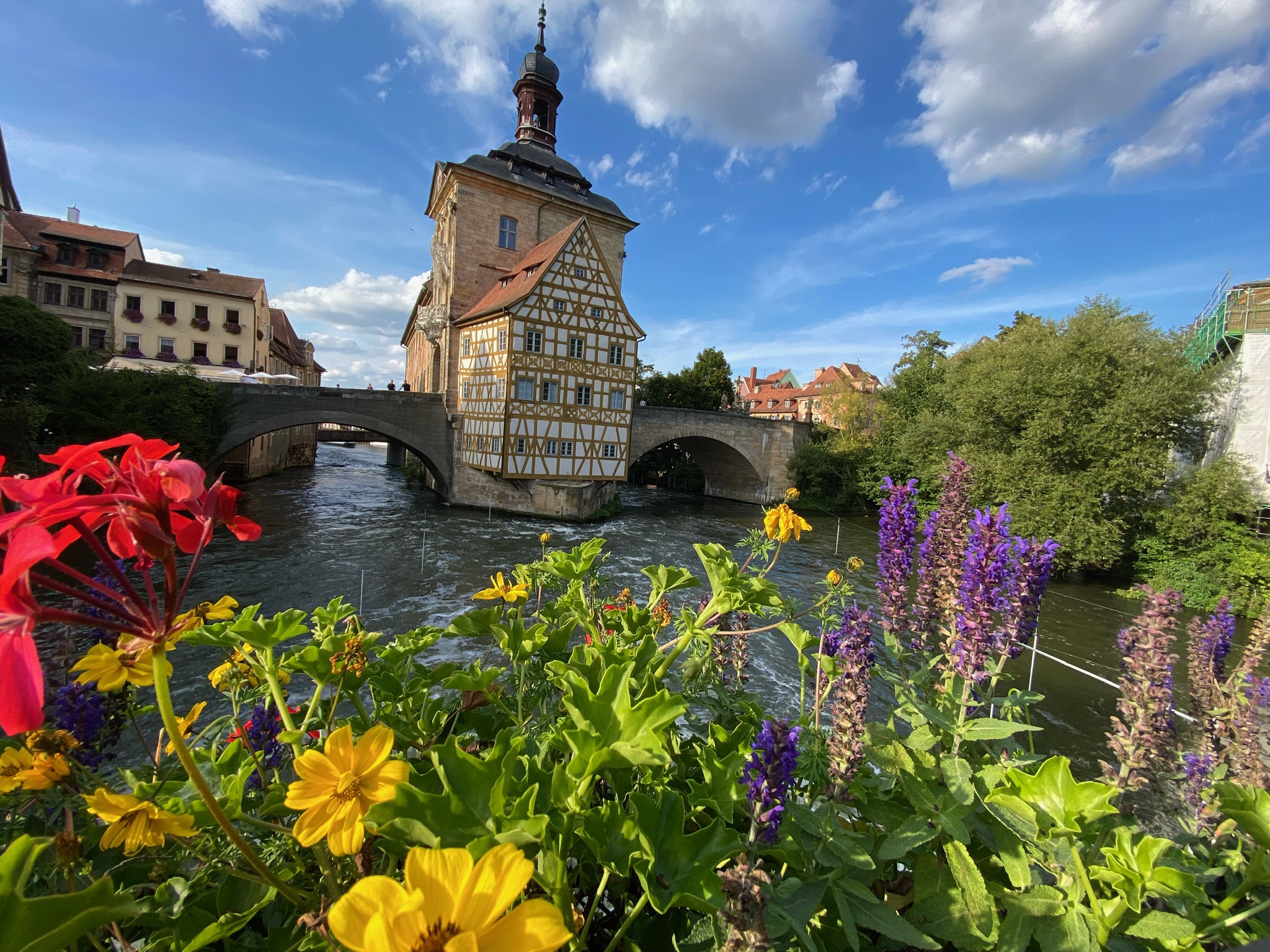
Bamberg, like Rome, is built on seven hills atop which sit impressive structures with commanding views. Altstadt Bamberg was a political force in Medieval times, beginning with the construction of Babenberg Castle in the 800s atop Cathedral Hill. Then, in 995, Heinrich (973-1024) became the Duke of Bavaria and moved to the castle with his royal court – Bamberg became the city that “Saint Henry the Exuberant” built. Heinrich, a descendant of Charlemagne the Great, was made King of Italy in 1004 and was crowned Holy Roman Emperor by Pope Benedict VIII in 1014. As Holy Roman Emperor, Heinrich chose Bamberg to be the capital of his empire and established the Diocese of Bamberg and the Cathedral.
In the early-Middle Ages, Bamberg became so powerful that it was visited by Popes Benedict VIII and the 2nd Bishop of Bamberg became Pope Clement II. In 1047, Pope Clement II was buried in the Cathedral and is the only Papal tomb North of the Alps. King of Germany Conrad III, who ruled from nearby Rothenburg, was also buried in Bamberg Cathedral in 1152 after he died here. During a period of no sitting Holy Roman Emperors, Conrad III was the most power man in Europe outside of the Pope, and his family held the Imperial crown for generations.
Today, Bamberg has earned a designation as a UNESCO World Heritage Site. It is one of the few German towns that escaped serious bombings during WW2. Therefore, it is an ideal stop for a couple days in which to walk its streets and enjoy its numerous architectural gems.
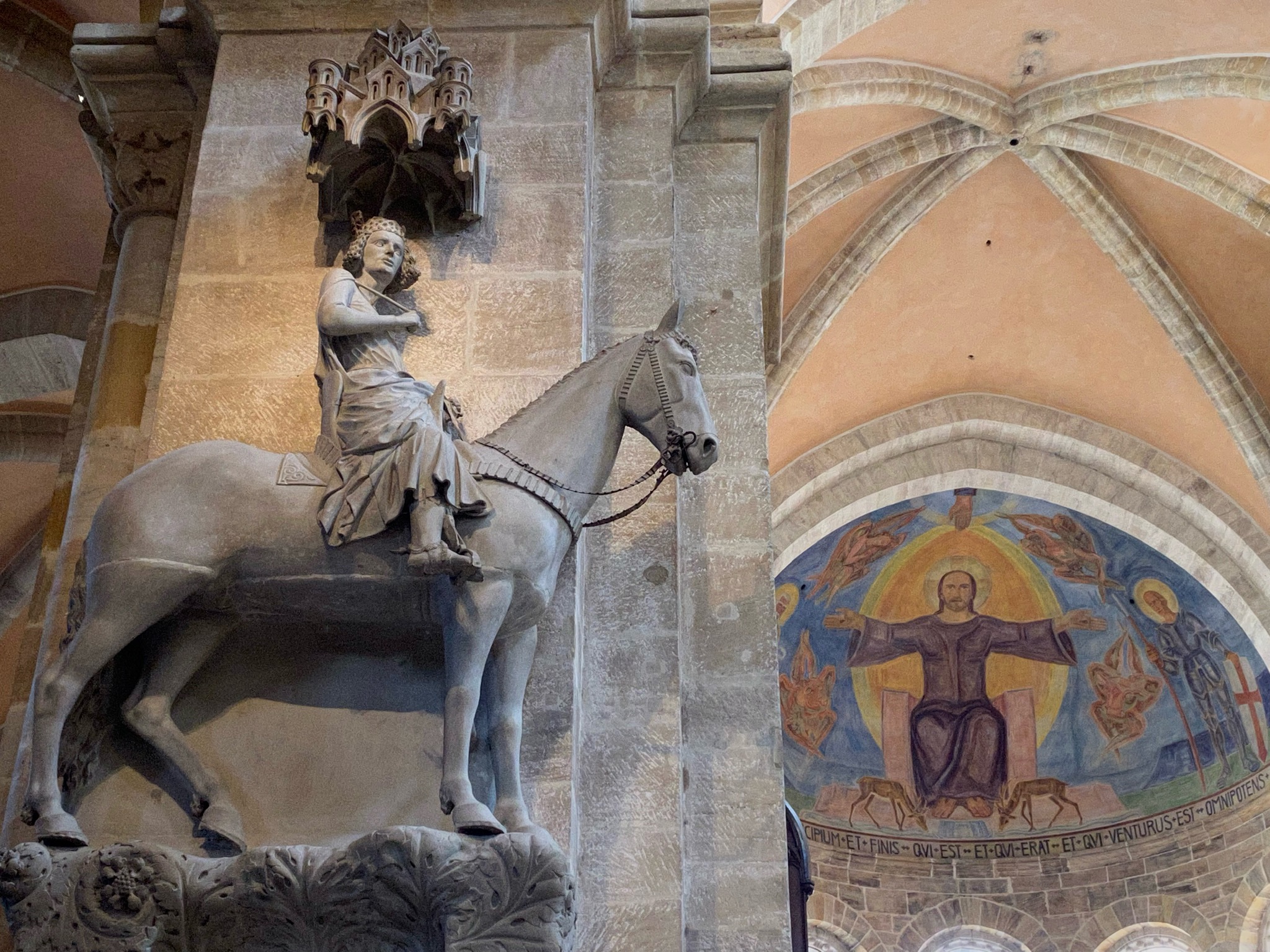
Atop Cathedral Hill is the Dom, St. Peter’s and St. George’s Imperial Cathedral. Holy Roman Emperor Heinrich II had the Cathedral constructed as early as 1002. Taking only ten years to complete, this version and the second version burned. The third attempt, stylistically Romanesque and early gothic, has survived. Inside, I find the tomb of the imperial couple Kunigunde and Heinrich II; tho buried here in 1024 their tomb wasn’t finished until 1513. Close by is the interesting Bamberg Rider sculpture.
The Bamberg Rider was carved about 1230 and is considered the first life-size equestrian statue since classical antiquity and the first to show a detailed horseshoe. It is oftentimes described as “mysterious” as it is unclear who the rider is. However, more interesting is the legend that a poem about the Bamberg Rider influenced Claus von Stauffenberg, the would-be assassin of Hitler and a member of the cavalry unit from Bamberg.
Following the end of the Thirty Years’ War in 1648, the Bishop had the interior of the Cathedral redecorated in a brightly colored Baroque style. Nearly 200 years later in 1847 Bavarian King Ludwig I had the bright interior removed to return the church to its Medieval appearance. Perhaps this is why I found other Bamberg churches more impressive; evidently I like the bling of Baroque.
Across the huge cobblestone plaza is Neue Residenz. Construction of the palace began in 1613 and until 1802 it served as the seat of Bamberg’s prince bishops who spiritually and administratively ruled the region for centuries.
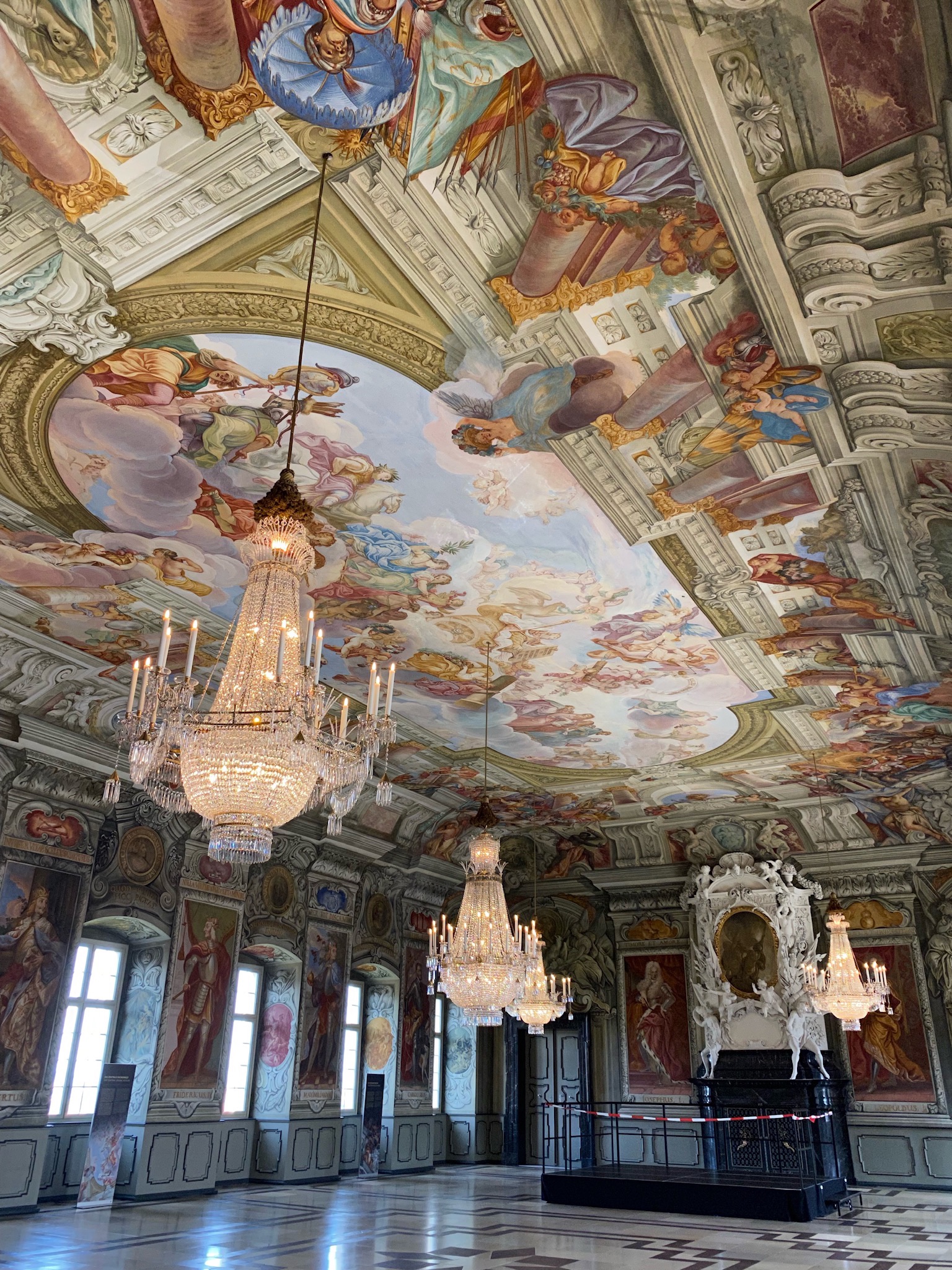
Two Baroque wings are open and reflect the quiet elegance of a neo-classical style with wonderful stucco ceilings and bright frescoes of the 17th and 18th centuries. The State Gallery includes numerous masterpieces of the late gothic and Baroque periods, including the sobering “Deluge.” White Hall is just that, white. Even so, the Hall and other apartments are tastefully decorated. The pièce de résistance of the residenz is the Imperial Hall (at left) and its paintings which include 16 imperial portraits of the Bavarian Wittelsbach emperors. Behind the Residenz is a lovely rose garden with wonderful views over Bamberg.
After the de-secularization of the church in 1803, the New Residence was often home to the Bavarian royal family on their visits to Bamberg. On December 4th, 1808 Duke of Bavaria Maximilian Joseph was born here. Maximilian Joseph is best known as the father of the Austria-Hungary Empress Elisabeth, the beloved ‘Sisi’.
Across the Domplatz is the Bamberg Historical Museum. Entry is through the Alte Hofhaltung (Old Court Yard), once the home to the original Castle. There are many displays, artifacts, maps, and photos documenting the life of Bambergers over the centuries and their love and historic dependence on the River Regnitz which flows through and around the city. Displays highlight the city from prehistory times into the 21st century and includes everything from a 1692 world globe to Mastodon molars. Most is in German.
A short walk behind the Dom is Pfarrkirche Unsere Liebe Frau or High Parrish Church of Our Lady. It is an impressive 14th century gothic church with flying buttresses and a beautiful interior displaying Baroque statues, carved gothic choir, and ornate Baroque alter. The soaring ceiling and frescoes are stunning. The painting “The Ascension of Mary” by Tintoretto is a particularly valuable work of art, displayed on the right as I enter the church.
At right, “the bling of Baroque”
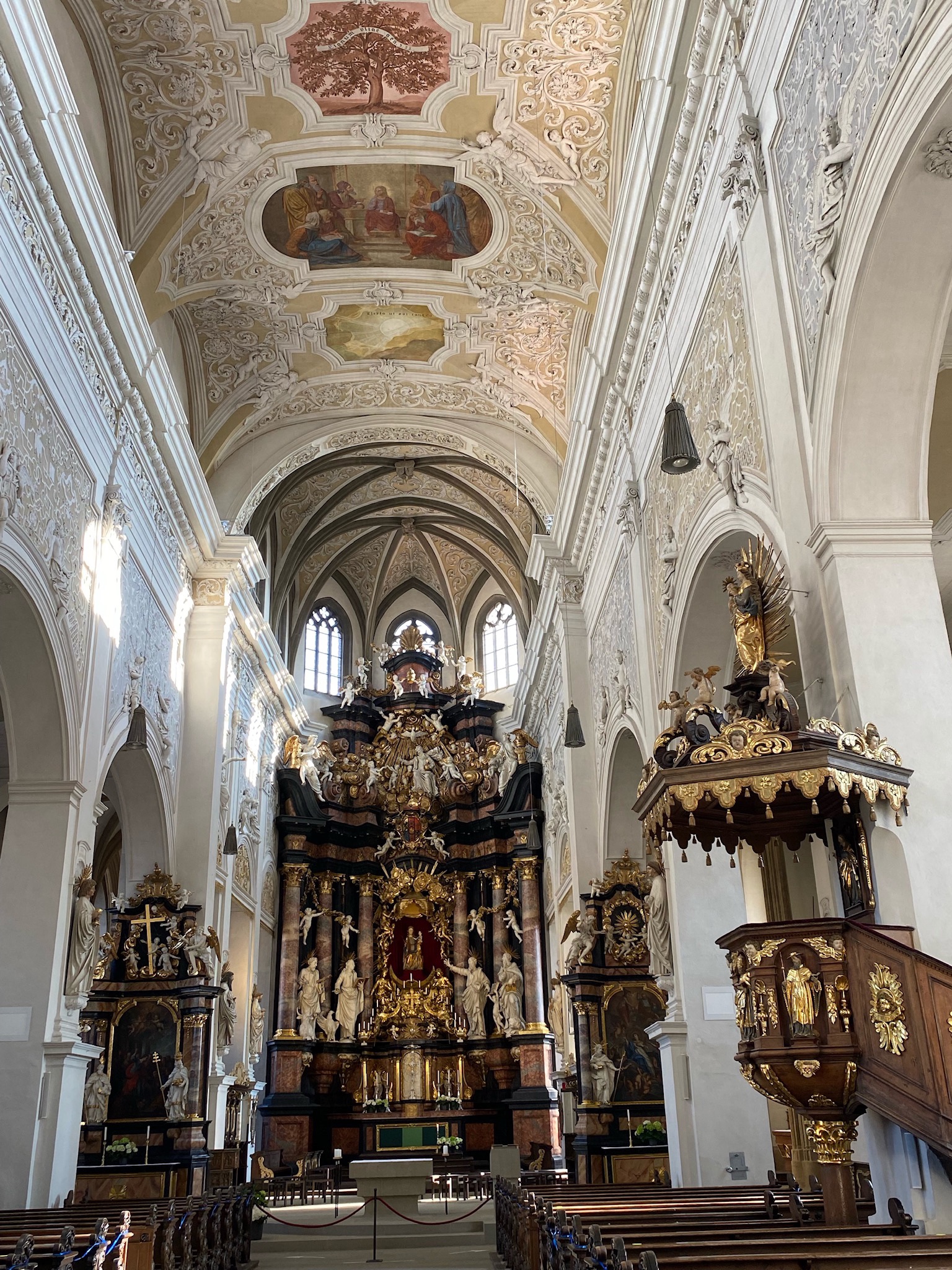
St. Michael’s Monastery is a former Benedictine monastery founded in 1015. It is closed for renovations so don’t make the climb unless desperate for a view, which is not that great. However, do walk up the steps and path thru the orchards of apples, pears and grapes. Until the 18th century, Bamberg was a wine-growing area as well as a beer producing town, and the local gardeners’ project is to revitalize the vineyards. The air is fragrant with the smell of newly cut hay and I can imagine a monk with his scythe cutting it this morning with the sunrise.
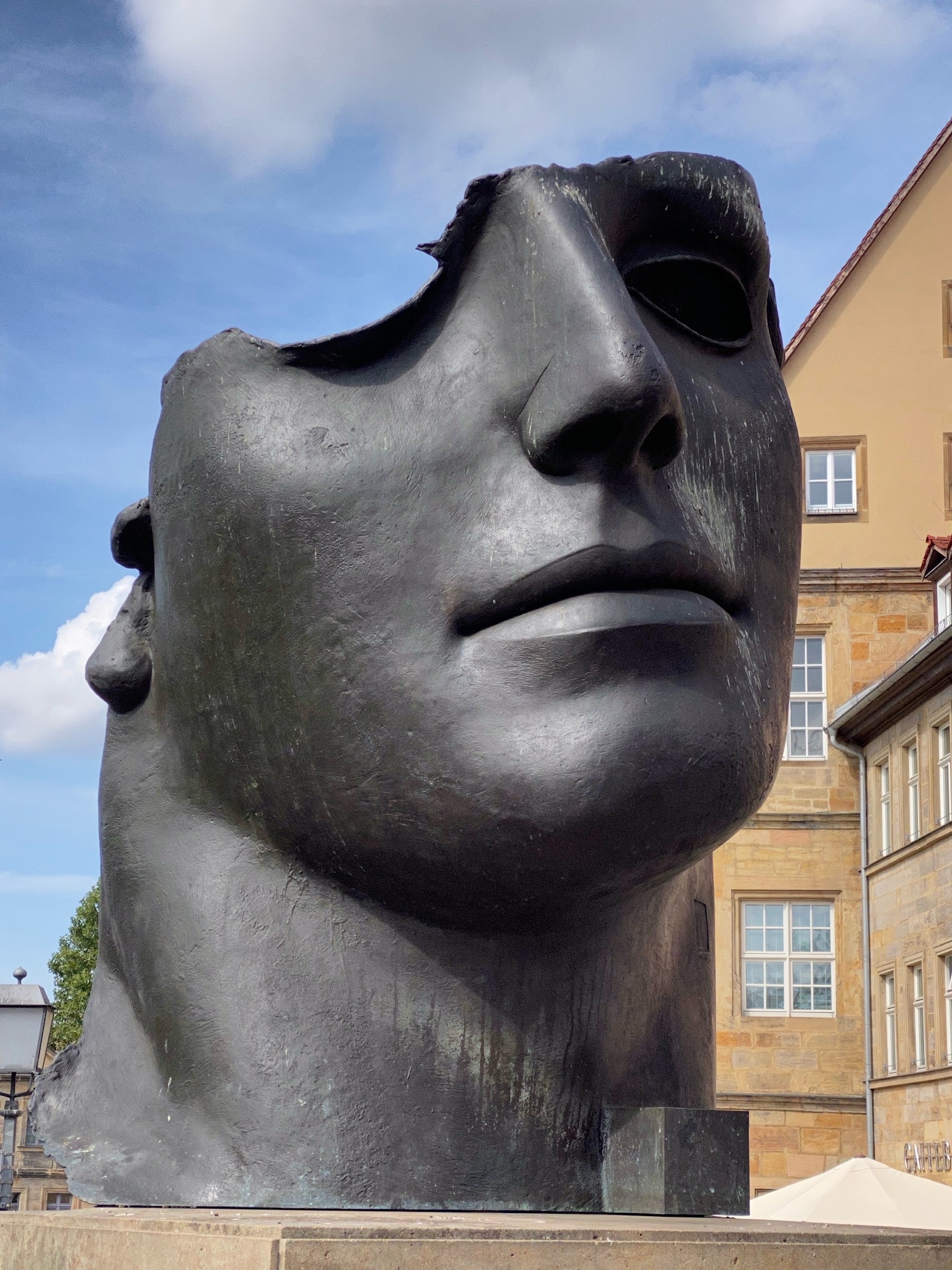
Strolling the streets of Altstadt, one discovers many artistic efforts and architectural marvels. I enjoy historical statues and fountains like those of Maximilian at the top of the lengthy Gruner Markt, the small Humsera which depicts an old market haggler, and the Neptune fountain at its end. At the opposing end of the art spectrum is the wonderfully modern Igor Mitoraj sculpture Centurione I. Mitoraj (1944-2014) was a Polish sculptor known for his large-scale fragmented sculptures of the human body. The presence of Emperor Heinrich II and his consort Saint Kunigunde can be seen all about Bamberg. Then there is the fascinating red lacquer Meeting by Chinese artist Wang Shugang in Schönleinsplatz.
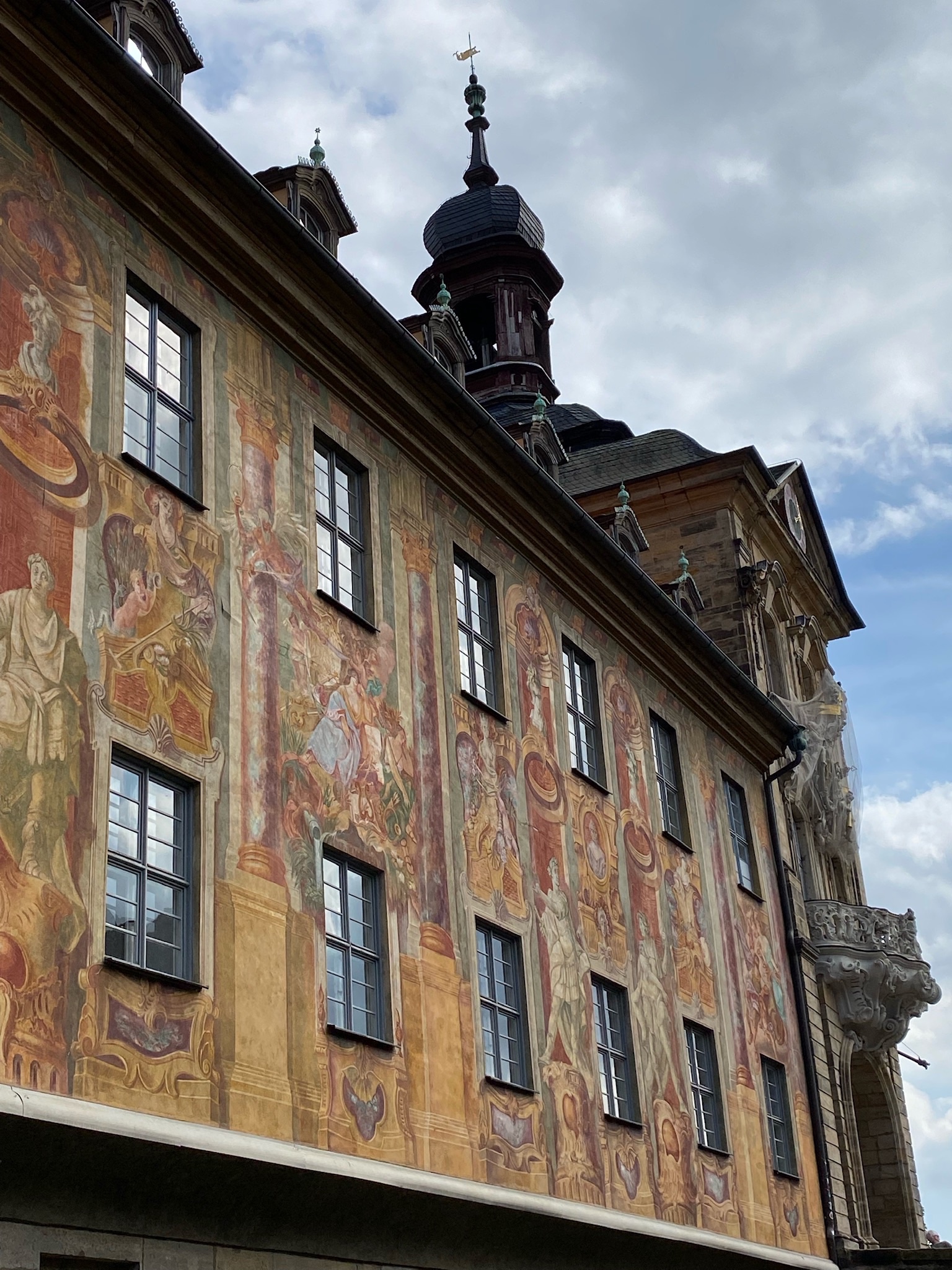
Spanning the flowing waters of the Linker Regnitzarm is the gorgeously frescoed Altes Rathaus. It actually is located in the middle of the Upper Bridge. While the old town hall has been here from the end of the 14th century, the existing structure was rebuilt in the middle of the 18th century. It’s a stunning piece of architecture, in particular, due to the vibrant frescoes adorning its facade which depict the story of how the building came to be built on the island. Don’t miss the whimsical putti’s chubby leg extending out of the wall as part of the eastern facade.
Escape the pedestrian streets crammed with shopping and wander down quiet lanes into the former fishermen’s district on the Regnitz. This is known as Little Venice where houses are considered “pearls of the River.” It is characterised by half-timbered buildings from the Middle Ages with tiny gardens and boats floating under the balconies. Walk along the River and into the neighborhoods which gave this city the nickname “Little Venice of the North.” Bamberg may have been caught up in the Thirty Years War and even their own version of witch trials in the Middle Ages, but it escaped the bombing and destruction of WW2 so it remains a beautiful example of medieval architecture.
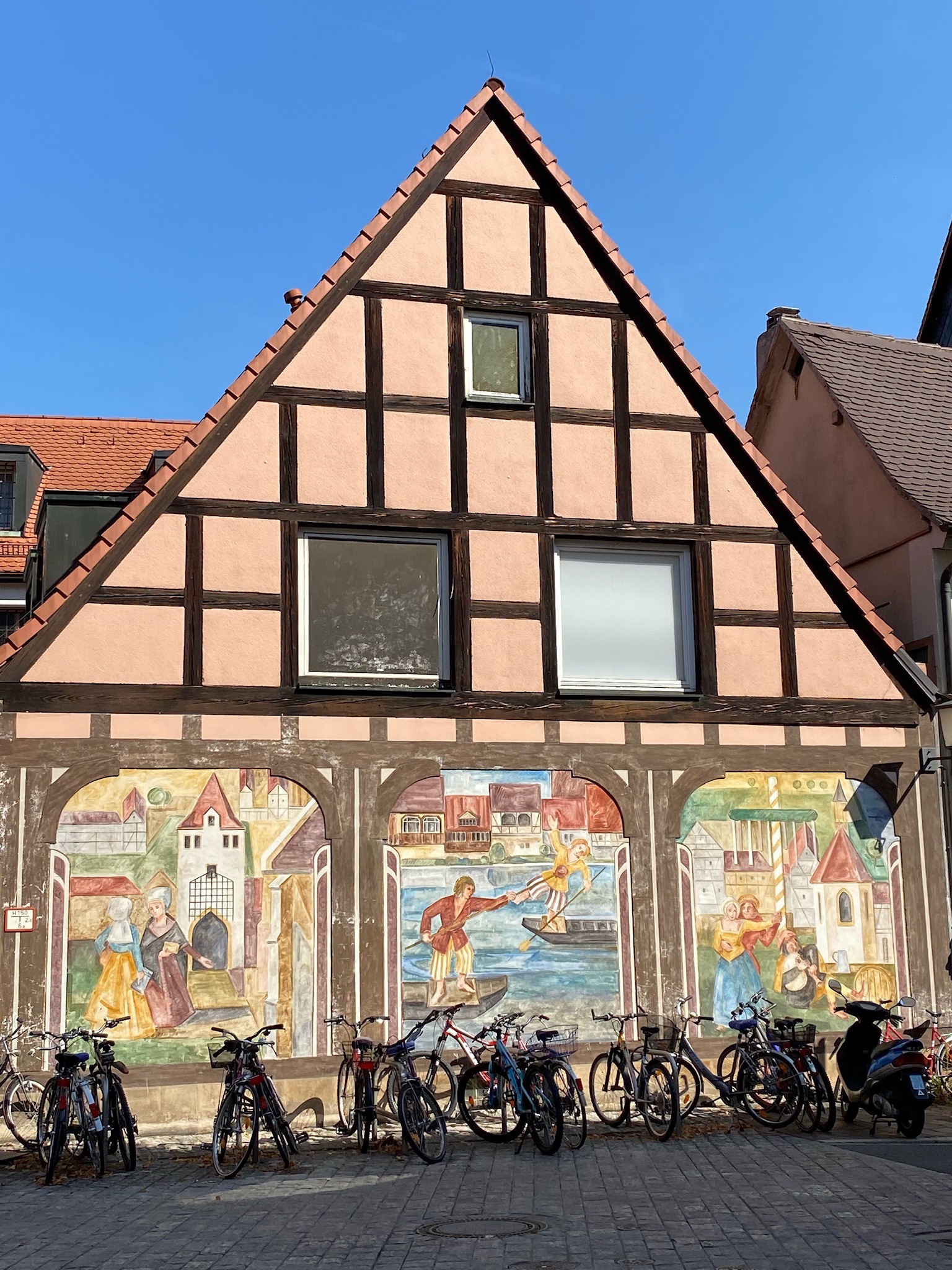
Which leads me to a last discovery about Bamberg. During the 30 Years War, the population of Bamberg shrunk by more than 40% due to religious conflicts, plagues, and famines. To retain their power during these turbulent times, the churches blamed the Devil for local problems and sought out scapegoats. This led to mass witch hunts which saw over 1,000 people murdered in the Bamberg region. (20,000 people around Germany and 60,000 in Europe were documented to be the victims of these Medievals witch trails.)
People in Bamberg were sent to prison after being accused of witchery by enemies, neighbors, and even family members. There was a very active torture chamber not far from Gruner Markt. On 11 February 1632, the Protestant Swedish army marched into Bamberg and closed down the Witches’ Prison, which was torn down a few years later. This all sounds similar to the new laws coming out of Texas on woman’s rights to abortion, except Texas women don’t have Gustavus Adolphus’ army riding in to beat back the sadists.
0 Comments